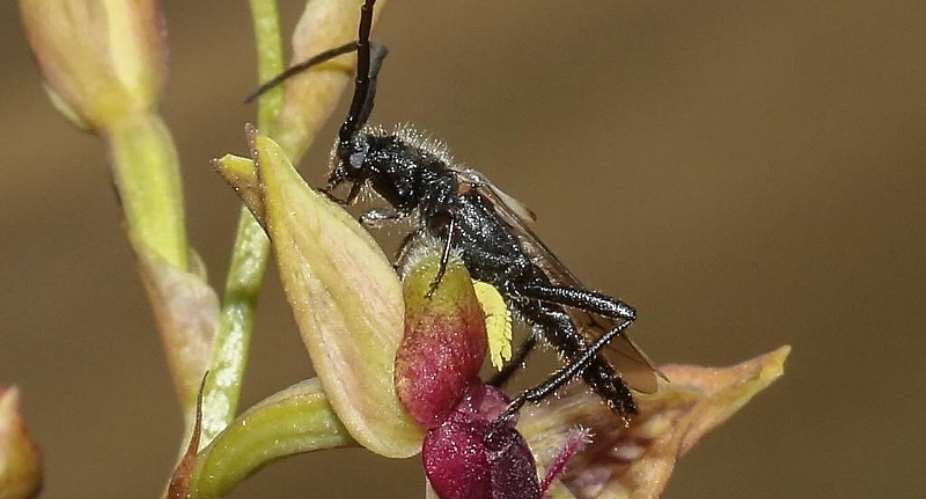Scientists in South Africa have discovered that an extremely rare orchid tricks male beetles into having sex with it so that the unwitting insects will carry out pollination. The orchid, known to science as Disa forficaria, grows flowers that resemble female longhorn beetles.
The plant, which produces no nectar or other food rewards for insects, emits a scent that male longhorn beetles evidently find irresistible.
Once settled the beetles, known as Chorothyse hessei showed “protracted mating behavior that culminated in ejaculation onto the flowers,” the scientists wrote in their paper published in the journal Current Biology.
Sexual deception
“The exclusive attraction of male C. hessei beetles and their obvious sexual behavior… provide very compelling confirmation of sexual deception in this system,” they add.
Crucially, the beetles were also observed picking up and depositing pollen on the flowers.
“Sexual deception is therefore probably the key explanation for the persistence of D. forficaria at extremely low densities,” they wrote.
The orchid is so rare it was once thought to be extinct: only 11 sightings of the plant have been recorded since the early 1800s. A single plant was found in 2018, the first in 52 years. It was in a place called Hermanus, situated in what is known as the Cape Floristic Region, which is home to thousands of unique plants.
One of the authors of the study, Steve Johnson, said he never expected to see one of these orchids in his lifetime.
The scientist, an orchid pollination specialist at South Africa's University of KwaZulu-Natal, only became involved in the study after he saw a photograph of the orchid-beetle interaction first witnessed by Cape Town-based ornithologist Callan Cohen, who co-authored the study.
“I was then able to observe the interaction with my own eyes,” Johnson told RFI.
Big surprise
But the scientists were in for another big surprise.
After isolating the chemical compound responsible for attracting the insects in the laboratory, they tested it at field sites in Hermanus. It attracted dozens of male longhorn beetles, three of which were caught and found to be carrying pollen packages.
These were tested and found to contain pollen from D. forficaria orchids.
“Thus we know that other individuals of the orchid must exist around Hermanus and one day we hope to find them,” Johnson said.
The scientists discovered that the pollinating beetles were also present on the Cape Peninsula, around 140 kilometres from Hermanus, where the orchids were historically known to exist. This shows “that there is potential for re-establishment of populations,” they wrote.
Rupert Koopman, conservation manager for the Botanical Society of South Africa, who was not part of the study, described the findings as "another astonishing example of the extremely intricate mutualisms happening in our natural systems."
But he told RFI that preserving this rare orchid relies less on re-establishing populations, and more on protecting the unique shrublands (known as the fynbos) where the orchid grows.
“The key to our endemic plants persisting is to ensure these natural habitats remain intact, healthy and managed so that these natural processes can continue,” he said.





 Ejisu by-election: Aduomi warns NPP against voter intimidation
Ejisu by-election: Aduomi warns NPP against voter intimidation
 High Court orders implicated four NDA officials to present defence
High Court orders implicated four NDA officials to present defence
 Let’s all be matured, patriotic to have a peaceful election this year – Dampare ...
Let’s all be matured, patriotic to have a peaceful election this year – Dampare ...
 Mahama's administration saw thievery that knew no bounds; stole from market wome...
Mahama's administration saw thievery that knew no bounds; stole from market wome...
 GRA/SML deal: Always read the stories behind the headlines or you'd look stupid ...
GRA/SML deal: Always read the stories behind the headlines or you'd look stupid ...
 GRA/SML Contract: It takes some 'wild' boldness for a president to make this dec...
GRA/SML Contract: It takes some 'wild' boldness for a president to make this dec...
 Elisu By-election: "If you call yourself a man, boo Chairman Wontumi again" — Bo...
Elisu By-election: "If you call yourself a man, boo Chairman Wontumi again" — Bo...
 Fuel tanker driver escapes with his life after tanker goes up in flames near Suh...
Fuel tanker driver escapes with his life after tanker goes up in flames near Suh...
 Uniform change: ‘Blue and white are brighter colours’ — Kwasi Kwarteng explains ...
Uniform change: ‘Blue and white are brighter colours’ — Kwasi Kwarteng explains ...
 MoE not changing all public basic school uniforms but only newly built ones — Kw...
MoE not changing all public basic school uniforms but only newly built ones — Kw...
